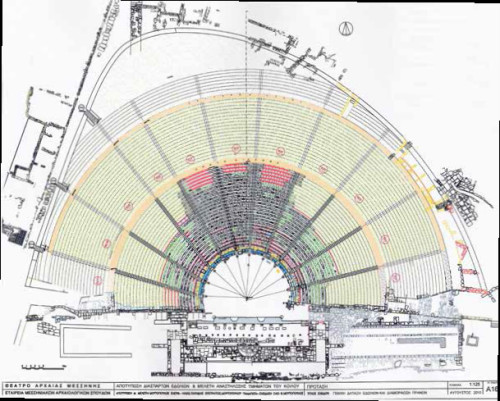The creative collaboration between AUEB and Diazoma bears fruit
Project Lavrio year 2023-2024. Completion of the innovative action “Education, Entrepreneurship and Culture” for the academic year 2023-2024 between the Teacher Education Program of AUEB, the Association “Diazoma” and the collaborating bodies
Elafonisos Eco Week; 10 – 16 June 2024
Spring Rites and the Crocus Collectors of Thera
Demolition of the Expropriated Buildings on the Site of the Ancient Theatre of Acharnes Commences
Research Study
Petros Themelis with a contribution on the mason marks by Kleanthis Sidiropoulos

ABSTRACT
The Messene theatre, built in the 3rd century BC and abandoned in the late 4th century AD, was used for both performances and political assemblies, according to literary and epigraphic testimony. The cavea, which is divided in eleven cunei, is supported by a strong retaining wall with arched gateways leading to the upper diazoma. No traces of the 3rd century BC wooden stage remains; the 2nd century BC scene building would have been rolled away on wheels and stored in a skenotheke. A ramp on the west side leads to the lower diazoma. Manumissions are inscribed on some of the stone seats. Six thrones for city dignitaries and several bases for honorary statues are set around the orchestra. A permanent stage with a proscenium of slender Ionic columns and semi-columns was constructed in the 1st century AD. A colossal three-storeyed scenae frons with a low broad pulpitum, constructed in the second half of the 2nd century AD, replaced the previous permanent stage; it was financed by Tiberius Claudius Saethidas Caelianus II, high priest of the Sebastoi for life and Helladarch of Achaia. The sculptural programme of the scenae frons is related to his ancestors and the Roman emperors Trajan, Hadrian, Septimius Severus, Marcus Aurelius and Lucius Verus with whom the family kept close ties. He was questor of the province Sicilia, augur and tribunus of the plebs and patron of the coloniae Abellinatum in Italy. Marble statues were erected in the niches of the scenae frons of Isis Pelagia, of Hermes and two portraits on Hermaic stelai. The Christianised inhabitants constructed their houses on the epitheatron and a built basilica nearby. The contribution on the mason marks focuses on the masons’ marks used in the different phases of the theatre at ancient Messene, on each occasion only in specific parts of the structure. Different systems of counting or of making signs to facilitate construction and repair have been observed in the retaining walls, in the scene building and in the sculptural decoration of the theatre. This study aims to contribute to the understanding of the structure’s architectural planning, the reconstruction of its exterior and ground plan and the dating of the individual construction phases, based on the mason’s marks.